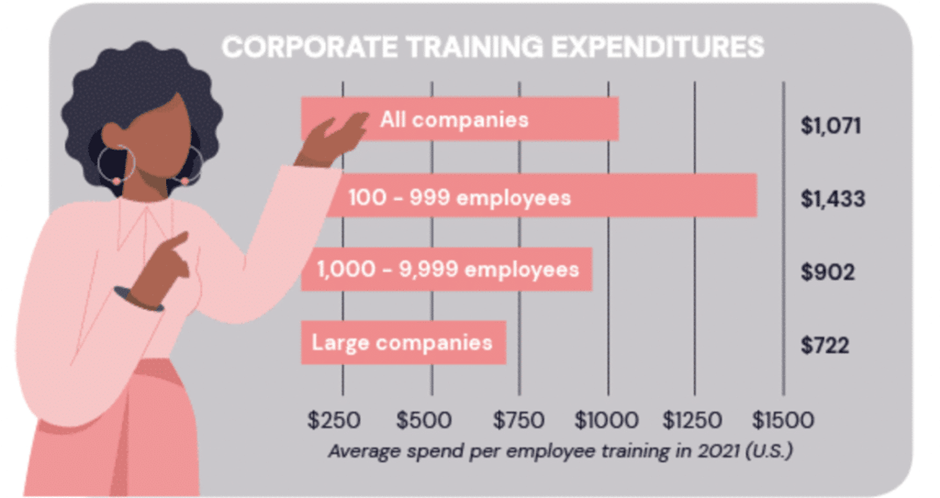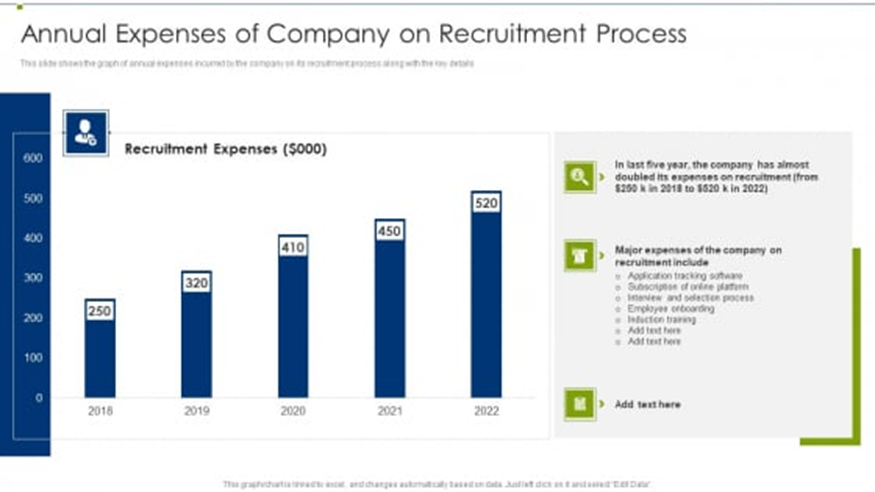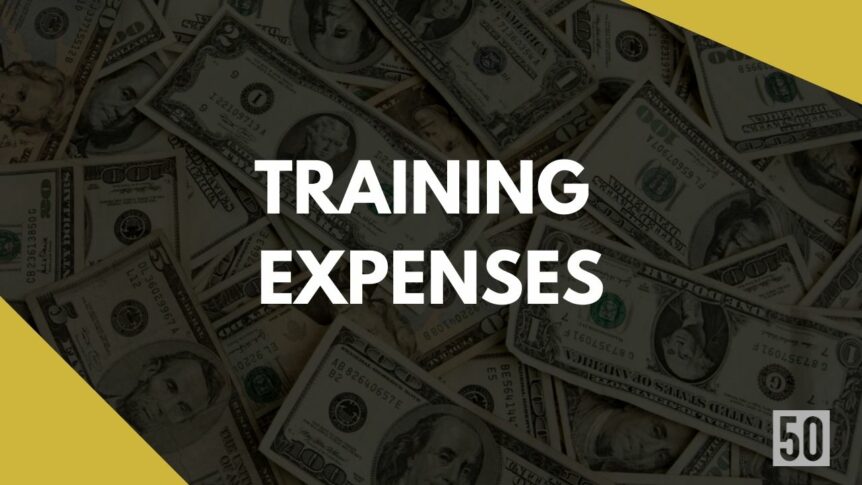Businesses, regardless of size or industry, have one common goal: to be successful. And while there are many ways to achieve this success, one key ingredient is continuous training and development of employees. Unfortunately, training can be expensive, and it’s not always easy to know where to start. In this blog post, we’ll discuss some tips for minimizing training expenses while still providing a high-quality experience for employees. Stay tuned!
What are Training Expenses?
This metric will keep a track of the company’s training expenses. Employee training is an essential part of any company’s success. By investing in the development of your employees, you are ensuring that they have the skills and knowledge necessary to contribute to the organization in a positive way.
This metric tracks the cost of all training expenses, including materials, fees for instructors, and travel costs. By monitoring this metric closely, you can ensure that your training budget is being used efficiently and effectively.
Why Is It Important For Startups To Track This Metric?
Tracking training expenses is essential for startups to ensure that their resources are being used efficiently and effectively. Training expenses can quickly add up, especially as a startup grows in size. By tracking training expenses, startups can establish budgets, monitor performance, and develop strategies to maximize the return on their investment.
Tracking training expenses also helps startups remain competitive by equipping their employees with the latest skills and knowledge needed to succeed in their positions. Additionally, tracking training expenses ensures that employees are able to access quality training opportunities and have the necessary resources to do their best work. Lastly, tracking training expenses can provide valuable insights into which areas of a business need improvement and suggest ways to optimize resources for maximum impact.
How do you calculate Training Expenses?
When it comes to training expenses, there are a few different ways to calculate the total cost. First, you can simply add up all of the training expenses incurred. This will give you the total dollar amount that has been spent on training.
Here’s the formula:
($) training expense 1 + ($) training expense 2 + … = ($) Training Expenses
What are the different ways to calculate training expenses?
You can also measure how much of your training budget has been spent, using the following formula: total training expenses divided by total training budget equals the percentage of budget spent.
($) total training expenses / ($) total training budget = (%) Training Budget Spent
Finally, you can establish the average spend per employee by dividing the total training expenses by the number of eligible employees.
($) total training expenses / (#) eligible employees = Average Training Spend
Whichever method you choose, calculating training expenses is an important way to track and manage your budget.
What factors affect Training Expenses?
Here are some factors that affect training expenses:
Duration of Training Program
The duration of the training program will affect the cost of training. Longer programs require more resources, materials and instructor time which can drive up costs.
Location
The location of the training sessions will also be a factor in determining expenses. It may be more cost-effective to provide training onsite, but there may be additional costs associated with travel, lodging, and meals if the training is held offsite.
Materials
The materials used for the training program will also factor into the cost of training. Printed materials such as handouts, manuals or workbooks may add to the expense of a program. Technology such as software, hardware or specialized equipment can also increase the cost.
Instructor Fees
The instructor fees for conducting the training will be a major factor in the overall cost of training. Instructors may charge an hourly rate or a flat fee, depending on their experience and qualifications.
Number of Participants
The number of participants enrolled in the program can also affect the cost of training. More participants may require additional materials and instructor fees, which can increase the expense of a program.
Time Spent Preparing
The amount of time spent in preparing for the training program can also add to the expense as it requires additional resources, materials and instructor time.
On-Going Support
Providing ongoing support and follow-up training sessions will also affect the cost of a program.
Measurement Tools
Investing in measurement tools to assess the effectiveness of the training can be a costly endeavour but can pay off in terms of improved performance and productivity.
Certification Fees
If certification is offered as part of the program, there may be additional fees associated with the certification process.
Incentives
Offering incentives to participants for taking part in the training can increase costs but can also help motivate participants and improve their overall learning experience.
What are the effects of Training Expenses on a startup?
Training expenses can have a significant impact on the success of a startup. A startup’s training budget is often one of its biggest investments, and it requires careful planning and consideration to ensure that the company’s resources are being allocated in the most effective way. By tracking training expenses, startups can evaluate the effectiveness of their spending and make informed decisions about further investments.
One of the most important effects of tracking training expenses is that it helps startups measure their return on investment (ROI) in terms of increased employee productivity. Training can be expensive, but if properly planned and implemented, it can lead to improved performance from employees, improved customer satisfaction rates, and ultimately higher profits. Tracking training expenses enables startups to measure their progress and adjust as needed.
Another key effect of tracking training expenses is that it can help startups determine which areas of training should be given priority. By monitoring the costs associated with different types of training, startups can decide where to allocate resources for better results. This helps ensure that money is spent on those initiatives that will have the greatest positive impact on the company.
What are good Training Expenses?
While the amount you spend on employee training will vary depending on your business needs, a good rule of thumb is to allocate 2 – 2.5% of your company’s budget to training expenses. By making the commitment to invest in your employees’ development, you will position your business for long-term success.
Training Expenses Example
The 2021 Training Industry Report from Training Magazine reveals that the amount of money spent per employee on training costs by an average U.S. company has gone down by $40 this year, to a total of $1,071 per person.
The size of the company has a major impact on per-person training expenses. Small companies (100 to 999 employees) saw the biggest decrease, reducing their expenditure from $1,678 in 2020 to $1,433 in 2021. Mid-size companies (1,000 to 9,999), however, doubled their spending—moving from $581 in 2020 to $902 in 2021. Large companies experienced a drop of 20 percent, decreasing their cost from $924 in 2020 to only $722 in 2021.

Let’s take a look at the graph below. It presents the annual expenses incurred by the company on its recruitment process. Deliver and pitch your topic effectively using this Recruitment Training Program For Workforce Annual Expenses Of the Company to gain maximum benefit.

What are tips to Manage Training Expenses?
Here are some tips for managing your training expenses:
1. Set a training budget:
Establish a budget for all upcoming training and stick to it. Outline how much money needs to be allocated for each training program, and make sure there is enough within the overall budget to cover them all.
2. Look for cost-effective solutions:
Consider alternative methods such as e-learning, online materials, and webinars to reduce the cost of traditional in-person training.
3. Leverage existing resources:
Examine what training materials you already have available that can be used for upcoming programs. Reusing existing materials can help save time and money.
4. Negotiate with vendors:
Get quotes from multiple vendors and negotiate with them to get the best deal.
5. Track spending:
Establishing an accurate record of training expenses helps you stay within budget and identify areas of savings. Make sure to track both direct and indirect costs associated with each program.
6. Utilize in-house experts:
Bring in your own internal experts or utilize a mentorship program when possible. This can help reduce costs associated with outside training programs.
7. Measure ROI:
Analyze the return on investment of each training program to determine if the cost is justified in terms of learning outcomes and productivity gains.
Conclusion
Training is a necessary evil for most businesses. The key to reducing training costs is to be strategic about when and how you train employees. By properly evaluating your needs, you can design a program that meets those needs without breaking the bank. Keep these tips in mind the next time you need to train new or existing employees and you’ll be sure to save your business some money.

